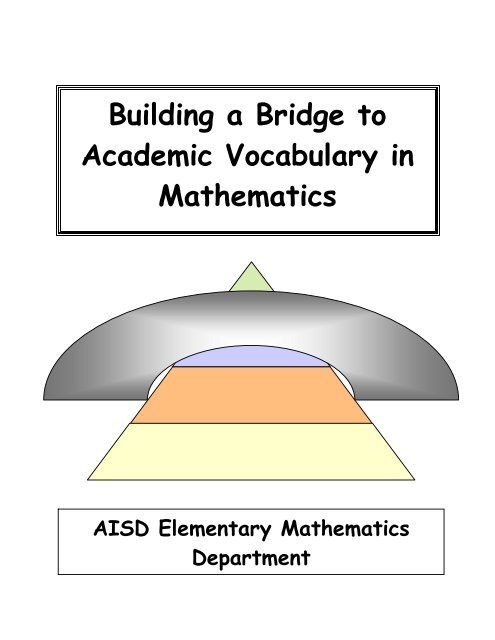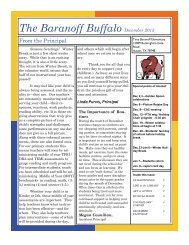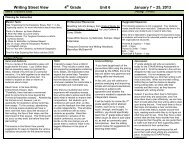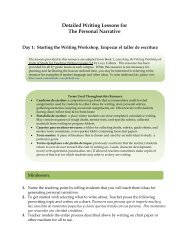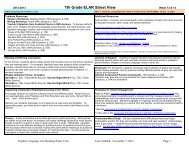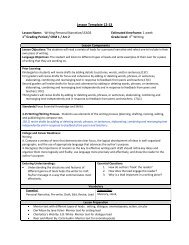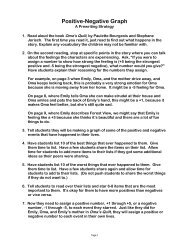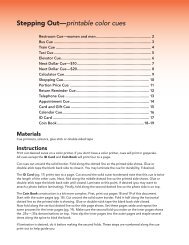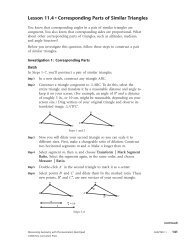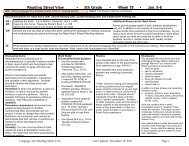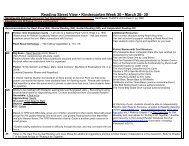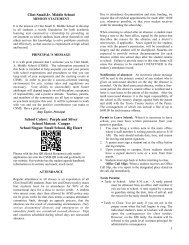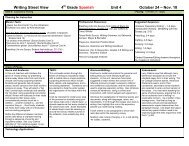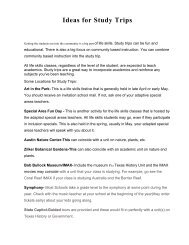Building a Bridge to Academic Vocabulary in Mathematics
Building a Bridge to Academic Vocabulary in Mathematics
Building a Bridge to Academic Vocabulary in Mathematics
You also want an ePaper? Increase the reach of your titles
YUMPU automatically turns print PDFs into web optimized ePapers that Google loves.
How Students Develop a Reper<strong>to</strong>ire of <strong>Academic</strong> English <strong>in</strong><strong>Mathematics</strong>Developed and researched by the AISD Elementary <strong>Mathematics</strong> DepartmentStudents do not learn mathematical vocabulary by memoriz<strong>in</strong>g def<strong>in</strong>itions. Rather,they construct mean<strong>in</strong>g for mathematical vocabulary by actually do<strong>in</strong>g authentic andmean<strong>in</strong>gful mathematics. Nevertheless, it is unrealistic for teachers <strong>to</strong> expect that allstudents will somehow absorb targeted vocabulary by simply engag<strong>in</strong>g <strong>in</strong> mathematical<strong>in</strong>vestigations. The teacher must be purposeful <strong>in</strong> construct<strong>in</strong>g learn<strong>in</strong>g experiences thatdirect the student’s attention <strong>to</strong> specific vocabulary. Consider the follow<strong>in</strong>g episodeobserved <strong>in</strong> an AISD 3 rd grade classroom <strong>in</strong> which the students are work<strong>in</strong>g withgeometrical concepts and vocabulary focus<strong>in</strong>g on congruency and transformations:Students <strong>in</strong> Mrs. Villareal’s third grade class at Brown Elementary were work<strong>in</strong>g onan end-of-unit assessment task from the Investigations unit, Flip, Turns, and Area. Thestudents were asked <strong>to</strong> look at the six arrangements of five squares shown below anddeterm<strong>in</strong>e how many of them are not congruent.One student wrote the follow<strong>in</strong>g explanation for why Shape A and Shape F arecongruent figures: “They’re the same but this one (an arrow is drawn <strong>to</strong> connect Shape A<strong>to</strong> Shape F) is just turned over.” Notice how this explanation, although it makes sense, isnot al<strong>to</strong>gether accurate. The student is right <strong>in</strong> that the two figures are <strong>in</strong>deed the same.However, if Shape A is turned, it will not look identical <strong>to</strong> Shape F. Instead, Shape A has<strong>to</strong> be flipped over and then turned so that it will have the same orientation as Shape F.Example of what Shape A wouldlook like if it were “turned”Example of what Shape A wouldlook like if it were “reflected”
In addition <strong>to</strong> his conceptual error <strong>in</strong> describ<strong>in</strong>g the correct motion that would makethese two figures’ orientation identical, this student’s failure <strong>to</strong> connect the formalmathematical term—rotation—<strong>to</strong> describe how Shape A was transformed <strong>to</strong> matchShape F’s orientation illustrates how students’ understand<strong>in</strong>g of word mean<strong>in</strong>gs is often<strong>in</strong>complete. Although Ms. Villareal had already <strong>in</strong>troduced the word rotation <strong>to</strong> herclass, this student had obviously not made a complete connection <strong>to</strong> this term<strong>in</strong>ology as away <strong>to</strong> label the correspond<strong>in</strong>g application or “turn<strong>in</strong>g” motion that positions a figure <strong>in</strong>space.This classroom episode shows the importance of expos<strong>in</strong>g students <strong>to</strong> multiple ways<strong>to</strong> represent their understand<strong>in</strong>g of mathematical concepts and formal vocabulary. Forexample, Ms. Villareal could have required her students <strong>to</strong> use the new term<strong>in</strong>ology—rotation, reflection, and translation—<strong>in</strong> their math journals as a way <strong>to</strong> reflect upon anddescribe what they did that day dur<strong>in</strong>g math time. This, however, is only one<strong>in</strong>structional strategy <strong>to</strong> further deepen the student’s understand<strong>in</strong>g of transformationalgeometric vocabulary. As with all types of learn<strong>in</strong>g, students need cont<strong>in</strong>uousopportunities that are purposefully and strategically orchestrated by the teacher <strong>to</strong> revisitand target mathematical vocabulary and concepts.What teachers should be foremost concerned about is not only if their studentsunderstand the mean<strong>in</strong>g of a new mathematical term, but also how they understand it. Inhis book, Elementary and Middle School <strong>Mathematics</strong>, Teach<strong>in</strong>g Developmentally, JohnVan de Walle promotes a “constructivist” theory that clearly expla<strong>in</strong>s how studentsshould learn mathematics:“Understand<strong>in</strong>g is a measure of the quality and quantity of connections that anew idea has with exist<strong>in</strong>g ideas. The greater the number of connections <strong>to</strong> anetwork of ideas, the better the understand<strong>in</strong>g.”The AISD Elementary <strong>Mathematics</strong> Department suggests that teachers follow Van deWalle’s constructivist theory when teach<strong>in</strong>g mathematical vocabulary <strong>to</strong> students. Werecognize that there is no prescribed format or ‘magical’ formula <strong>to</strong> ensure that ourstudents <strong>in</strong> AISD will understand and use academic mathematical English. Each studentwill have a unique understand<strong>in</strong>g of math vocabulary, rang<strong>in</strong>g <strong>in</strong> various levels ofcomplexity and sophistication as he/she cont<strong>in</strong>ues <strong>to</strong> grow as a mathematical th<strong>in</strong>ker.What this department does recommend is that teachers use a multi-representationalapproach <strong>to</strong> teach math vocabulary so that our students will have a stronger foundationand understand<strong>in</strong>g of formal mathematical term<strong>in</strong>ology before enter<strong>in</strong>g Middle School.This simply means that students must show and apply their learn<strong>in</strong>g with<strong>in</strong> the context ofreal mathematical experiences that offer many opportunities <strong>to</strong> revisit, apply, and showevidence of understand<strong>in</strong>g us<strong>in</strong>g a wide range of strategies and representations—draw<strong>in</strong>g,identify<strong>in</strong>g, classify<strong>in</strong>g, describ<strong>in</strong>g, and expla<strong>in</strong><strong>in</strong>g formal mathematical vocabulary.Through active discourse and <strong>in</strong>teraction with important mathematical ideas, theteacher must strategically plan learn<strong>in</strong>g experiences that purposefully bridge theirstudents’ <strong>in</strong>formal language <strong>to</strong> formal mathematical vocabulary. The rema<strong>in</strong>der of thisdocument provides <strong>in</strong>structional strategies that will help teachers construct this bridge forfuture student success with academic English <strong>in</strong> mathematics.
Informal vs. Formal Language and <strong>Vocabulary</strong>The table below lists some examples of <strong>in</strong>formal language used by students <strong>to</strong> describemathematical ideas. The proceed<strong>in</strong>g column lists the correspond<strong>in</strong>g formal mathematicalvocabulary:Informal <strong>Vocabulary</strong>SplitTake awaySlideTurnFlipChangeSameMoreLessHoldsInsideAroundCrossTotalFormal Mathematical<strong>Vocabulary</strong>DivideSubtractTranslationRotationReflectionTransformationCongruent/EqualGreaterFewerCapacityInterior/ AreaPerimeterIntersectionSum
5 Components for Scaffold<strong>in</strong>g Formal Mathematical <strong>Vocabulary</strong>The AISD Elementary <strong>Mathematics</strong> Department lists 5 components for scaffold<strong>in</strong>gstudents’ understand<strong>in</strong>g and use of <strong>in</strong>formal vocabulary with formal mathematicalvocabulary:o Model<strong>in</strong>g—The teacher uses the targeted vocabulary with<strong>in</strong>a mean<strong>in</strong>gful context, often “revoic<strong>in</strong>g” the student’s<strong>in</strong>formal language with the formal mathematical term<strong>in</strong>ology.Example: Student—“I split 14 and got 7.” Teacher—“So you mean that 7 ishalf of 14.” Student—“Yes, two 7’s make 14.” Teacher—“Yes, you candivide 14 by 2 <strong>to</strong> get a quotient of 7.”o Discourse—The teacher orchestrates activities and posesquestions that elicit student talk about mathematical ideas asthey arise with<strong>in</strong> the course of the lesson.Example: The students are mak<strong>in</strong>g arrangements with 5 color tiles. Theteacher makes two arrangements on the overhead and asks: “Are these twopen<strong>to</strong>m<strong>in</strong>oes congruent? How do you know? What do I mean by congruent?Take 5 m<strong>in</strong>utes and talk with your partner.”o Multiple Representations—The teacher uses variousgraphic organizers and displays—e.g. Venn Diagrams,concept maps, Frayer Models, tables, word banks/ banks,etc.—<strong>to</strong> re<strong>in</strong>force targeted vocabulary.o Writ<strong>in</strong>g—The students use the targeted vocabulary <strong>to</strong> reflec<strong>to</strong>n and organize their thoughts around related mathematicalideas—e.g. journals, justification of solution strategies, etc.o Assessment—The teacher uses <strong>in</strong>formal observation andformal assessment <strong>to</strong>ols <strong>to</strong> determ<strong>in</strong>e the depth <strong>to</strong> which thestudent understands and expla<strong>in</strong>s his/her understand<strong>in</strong>g us<strong>in</strong>gthe targeted vocabulary.
<strong>Build<strong>in</strong>g</strong> The <strong>Bridge</strong>:An AISD Model for Scaffold<strong>in</strong>g Students’ InformalLanguage With Formal Mathematical <strong>Vocabulary</strong>MultipleRepresentationsDiscourseWrit<strong>in</strong>gModel<strong>in</strong>gSwamp ofConfusion andMisunderstand<strong>in</strong>gAssessmentInformalLanguageFormal<strong>Vocabulary</strong>Where the student startsDest<strong>in</strong>ation**Note that these 5 components for scaffold<strong>in</strong>g formalmathematical vocabulary are not necessarily sequential.Instead, they are recursive and ongo<strong>in</strong>g.
Word BankOne way <strong>to</strong> re<strong>in</strong>force new vocabulary is <strong>to</strong> add words <strong>to</strong> a "word bank" <strong>in</strong> theclassroom. This is simply a visible location <strong>in</strong> the classroom for post<strong>in</strong>g wordswhere students can see them. It is helpful <strong>to</strong> post a student-created def<strong>in</strong>ition andan example next <strong>to</strong> the term. Add<strong>in</strong>g new vocabulary <strong>to</strong> the word bank gives it aconstant presence <strong>in</strong> the classroom. Children see the written word, use the wordorally, and, when they are ready, copy and write the word when they are expla<strong>in</strong><strong>in</strong>gtheir ideas <strong>in</strong> writ<strong>in</strong>g.We need <strong>to</strong> make many decisions as we provide opportunities for students <strong>to</strong>develop vocabulary and students need a wide variety of experiences <strong>in</strong> order <strong>to</strong>have a deep understand<strong>in</strong>g of the mathematical concept that is expressed <strong>in</strong>mathematical words. For example, we might th<strong>in</strong>k that add<strong>in</strong>g color makes a shapemore <strong>in</strong>terest<strong>in</strong>g, young children may associate color as an attribute of the shape.In other words, if a triangle is green, young children may develop the misconceptionthat all green shapes are triangles. Orientation of shapes is another commonmisconception. Multiple student-created examples, and sometimes non-examples,will address these issues.
Def<strong>in</strong><strong>in</strong>g/Describ<strong>in</strong>g Terms Us<strong>in</strong>gWord BanksAsk<strong>in</strong>g students <strong>to</strong> def<strong>in</strong>e or describe a mathematical term us<strong>in</strong>g words froma word bank helps them make connections between math vocabulary words.Below is an example of what this activity would look like if the directionswere written on the board or on the overhead. Use words from the relatedunit of study or from the Word bank. (The example below is not grade level specific.)Def<strong>in</strong>e the term fraction us<strong>in</strong>g these words from the Word Bank:Word Bankwholenumera<strong>to</strong>rdenom<strong>in</strong>a<strong>to</strong>rDef<strong>in</strong>e the term pentagon us<strong>in</strong>g these words from the Word Bank:Word BankpolygonsidesanglesDef<strong>in</strong>e the term cube us<strong>in</strong>g these words from the Word Bank:Word BankfacesedgesverticesDef<strong>in</strong>e the term circle us<strong>in</strong>g these words from the Word Bank:Word BankchorddiameterradiuscenterDescribe a ____________________ us<strong>in</strong>g the words <strong>in</strong> the Word Bank.
Def<strong>in</strong><strong>in</strong>g/Describ<strong>in</strong>g Terms Us<strong>in</strong>gWord Banks (Black l<strong>in</strong>e)Def<strong>in</strong>e the term __________ us<strong>in</strong>g these words from the Word Bank:Word BankDef<strong>in</strong>e the term __________ us<strong>in</strong>g these words from the Word Bank:Word BankDef<strong>in</strong>e the term __________ us<strong>in</strong>g these words from the Word Bank:Word BankDef<strong>in</strong>e the term __________ us<strong>in</strong>g these words from the Word Bank:Word BankDescribe a ____________________ us<strong>in</strong>g the words <strong>in</strong> the Word Bank.
Classify<strong>in</strong>g Terms Us<strong>in</strong>g the WordBank & Venn DiagramsAdditionMultiplicationInvolves sets thatcan have sameor differentnumbers ofobjectsLearn <strong>in</strong> grade k/1Can add acolumn ofnumbersMathoperationsInvolve putt<strong>in</strong>gobjects<strong>to</strong>getherCan use both<strong>to</strong> solve sameproblemInvolves sets thatalways have thesame # ofmembersHelps you solvesome problems morequicklyLearn <strong>in</strong> grade 2/3Extension: Write a s<strong>to</strong>ry problem that can be solved us<strong>in</strong>g addition ormultiplication. Solve it both waysFractionsWritten with onenumber above theother (e.g. ½)Whole can bedivided <strong>in</strong><strong>to</strong> anynumber of parts(e.g. ¾,½, ¼)recipesParts of awholeConcepts welearn about <strong>in</strong>math classYou can add,subtract,multiply, anddivide themWritten with adecimal po<strong>in</strong>tWhole is divided<strong>in</strong><strong>to</strong> 10, 100, 1000,etc. Parts (multiplesof ten)moneytemperatureBatt<strong>in</strong>g averagesDecimalsExtension: Expla<strong>in</strong> the difference between a fraction and a decimal.
Classify<strong>in</strong>g Terms Us<strong>in</strong>g the WordBank & Venn Diagrams (Black L<strong>in</strong>e)Extension:
Frayer ModelThe Frayer Model is a word categorization activity that helps learners developtheir understand<strong>in</strong>g of concepts. Students provide a def<strong>in</strong>ition, list characteristicsor facts, and provide examples and nonexamples of the concept. There are manyconcepts <strong>in</strong> mathematics that can be confus<strong>in</strong>g because of their close relationships(e.g. prime numbers and fac<strong>to</strong>rs) and/ or their specialized features (e.g. functions).This strategy provides students with the opportunity <strong>to</strong> understand what a conceptis and what it is not. It gives students and opportunity <strong>to</strong> communicate theirunderstand<strong>in</strong>g and <strong>to</strong> make connections by provid<strong>in</strong>g examples and nonexamplesfrom their own experiences with the concept.How <strong>to</strong> use it:1. Take a concept that might be confus<strong>in</strong>g because of its relational qualities.2. Expla<strong>in</strong> the Frayer model diagram.3. Model how <strong>to</strong> fill out the diagram by ask<strong>in</strong>g for items <strong>to</strong> list <strong>in</strong> the “examples”section. Then ask for nonexamples. By referr<strong>in</strong>g <strong>to</strong> the examples &nonexamples, ask students what facts or characteristics might be given aboutthe term. F<strong>in</strong>ally, ask students <strong>to</strong> use all the <strong>in</strong>formation discussed <strong>to</strong> come upwith a group def<strong>in</strong>ition of the term.4. When students are familiar with the diagram, let them practice with assignedterms.5. Once their diagrams are completed, let the students share their work withother students. Display students’ diagrams as posters throughout the unit sostudents can refer <strong>to</strong> the words and cont<strong>in</strong>ue <strong>to</strong> add ideas.Def<strong>in</strong>ition (In your ownwords)A simple, closed, planefigure made up of threeor more l<strong>in</strong>e segmentsFacts/Characteristics• Closed• Simple (curve doesnot <strong>in</strong>tersect itself)• Plane figure (2D)ExamplesPolygonNonexamples• Rectangle• Triangle• Pentagon• Trapezoid• Hexagon• Circle• Cone• Arrow (ray)• Cube• Letter ABar<strong>to</strong>n, M.L., & Heidema, C. (2002) Teach<strong>in</strong>g Read<strong>in</strong>g <strong>in</strong> <strong>Mathematics</strong> (2 nd ed.). Colorado: Mc Rel
Frayer Model (Black l<strong>in</strong>e)Def<strong>in</strong>itionFacts/ CharacteristicsExamplesNonexamples
ABC Bra<strong>in</strong>s<strong>to</strong>rm<strong>in</strong>gWhat is ABC Bra<strong>in</strong>s<strong>to</strong>rm<strong>in</strong>g?Before hav<strong>in</strong>g your students talk about a major <strong>to</strong>pic, it is essential <strong>to</strong> activatetheir background knowledge about it. One way <strong>to</strong> do this is the ABC Bra<strong>in</strong>s<strong>to</strong>rm.The idea is meant <strong>to</strong> be fairly simple. Students try <strong>to</strong> th<strong>in</strong>k of a word or phraseassociated with the <strong>to</strong>pic, matched <strong>to</strong> each letter of the alphabet.How Does It Work?Use that alphabet chart below or have students list the letters of the alphabetdown a sheet of paper. Let them work <strong>in</strong>dividually at first, th<strong>in</strong>k<strong>in</strong>g of as manywords as they can that could be associated with the <strong>to</strong>pic you identify. Note:The <strong>to</strong>pic should be big and general enough that students can actually th<strong>in</strong>k of alot of possible terms. Then, <strong>in</strong> no particular order, let them beg<strong>in</strong> fill<strong>in</strong>g <strong>in</strong> theblanks beside the letters of the alphabet.It seems <strong>to</strong> work well if you give student enough time <strong>to</strong> th<strong>in</strong>k of a lot if ideas butthen let them pair up or work <strong>in</strong> small groups <strong>to</strong> share ideas. In this way, you canlet the bra<strong>in</strong>s<strong>to</strong>rm<strong>in</strong>g function like a Th<strong>in</strong>k-Pair-Share. Then, let students sharepossible terms for the different letters of the alphabet as you record theirresponses on a large chart or chart paper. Be open <strong>to</strong> a wide range ofpossibilities! Make sure students know that you’re not look<strong>in</strong>g for exact answers,just justifiable and relevant ones.What sorts of Topics Are Good for an ABC Bra<strong>in</strong>s<strong>to</strong>rm?Topics you are <strong>in</strong>troduc<strong>in</strong>g so students have an anchor, or it can be a good recapfor <strong>to</strong>pics already studied.
ABC Bra<strong>in</strong>s<strong>to</strong>rm StrategyTitle: ________________________A B C DE F G HI J K LM N O PQ R S TU V W XYZ
Cue CardsIn this game, students match mathematics expressions <strong>to</strong> the verballanguage used <strong>to</strong> read them. This game could be used <strong>in</strong> a mathematics classas a review or as a novel way <strong>to</strong> practice with symbol vocabulary. Asstudents hear the expressions read aloud, they construct mean<strong>in</strong>g andvalidate their understand<strong>in</strong>g of symbols.How <strong>to</strong> use it1. Provide each student (or pairs of students with a set of six <strong>to</strong> eightcards. Each card should have a mathematics statement given <strong>in</strong>symbols.2. Prepare cue cards with phrases <strong>to</strong> read for the mathematicsstatement. You may have more than one cue card correspond<strong>in</strong>g <strong>to</strong> onestatement.3. Display and read the cue cards aloud one at a time. As each phrase ispresented, ask students <strong>to</strong> select and hold up a match<strong>in</strong>g responsecard. Visually check for correct responses.Set of cards for each student:n + 7 7 - n n/7 7/n7n n > 7 n < 7 n - 7Cue Cards:A number n isless than 77 more than anumber n7 divided by anumber nThe quotient of anumber n and 7A number ndecreased by 7The sum of anumber n and 77 subtractedfrom a number n7 less than anumber n7 is less than anumber nThe differencebetween n and 7The product of anumber n and 7A number n<strong>in</strong>creased by 77 times anumber n7 is greater thana number nBar<strong>to</strong>n, M.L., & Heidema, C. (2002) Teach<strong>in</strong>g Read<strong>in</strong>g <strong>in</strong> <strong>Mathematics</strong> (2 nd ed.). Colorado: Mc Rel
Cue Cards (Black l<strong>in</strong>e)n + 77 - nn - 77nn/7 7/nn > 7 n < 7
Cue Cards (Black l<strong>in</strong>e)A number n is lessthan 7A number ndecreased by 77 is less than anumber n7 divided by anumber n7 subtracted froma number nThe product of anumber n and 77 times a number n7 more than anumber nThe sum of anumber n and 7The differencebetween n and 7The quotient of anumber n and 77 less than anumber nA number n<strong>in</strong>creased by 77 is greater than anumber n
Concept CirclesA versatile categorization strategy for students <strong>to</strong> study words orterms critically, relat<strong>in</strong>g them conceptually <strong>to</strong> one another. With a conceptcircle, students identify common attributes or a concept relationship thatexists among several terms. As a pre-read<strong>in</strong>g activity, concept circles can<strong>in</strong>volve students <strong>in</strong> predict<strong>in</strong>g and discover<strong>in</strong>g relationships, beg<strong>in</strong>n<strong>in</strong>g theprocess of def<strong>in</strong><strong>in</strong>g a concept. As a re<strong>in</strong>forcement or extension activity,students identify a concept (perhaps more than one) that relates severalterms, terms, th<strong>in</strong>k<strong>in</strong>g about common attributes and extensions.How <strong>to</strong> use it:1. Choose common attributes or relationships among a number of terms.2. Draw a circle divided <strong>in</strong><strong>to</strong> sections (three <strong>to</strong> six) and put a term (wordor phrase) <strong>in</strong><strong>to</strong> each section, all of which have the identified attributesor are related <strong>in</strong> a similar way.3. Direct students <strong>to</strong> identify the common attributes or name therelationship that exists among the terms <strong>in</strong> all sections of the circle.Modifications:1. Leave one section of the circle empty and direct students <strong>to</strong> identifythe concept relat<strong>in</strong>g all the terms given <strong>in</strong> the other sections and <strong>to</strong>fill the empty section with a new term that also fits with this concept.2. Choose a term for just one section of the circle that is not an exampleof a concept and terms for all the other sections. Then direct thestudents <strong>to</strong> f<strong>in</strong>d the term that does not belong and identify theconcept that relates the other terms.Concept: Solid FiguresWhich term does notbelong?sphereprism2 5acuterightcyl<strong>in</strong>dercubeconepyramid11 13__obtuseparallelConcept: Prime Numbers
Concept Circles (Black L<strong>in</strong>e)Concept: _________________
ConceptCircles (Black L<strong>in</strong>e)
Concept Circles (Black L<strong>in</strong>e)Concept: _________________
Concept Circles (Black L<strong>in</strong>e)
ConceptCircles (Black L<strong>in</strong>e)Concept: _________________
ConceptCircles (Black L<strong>in</strong>e)
Word WebWord webs help students <strong>to</strong> visualize how characteristics, examples,and def<strong>in</strong>itions relate and support a specific t vocabulary word ormathematical symbol.How <strong>to</strong> use it:1. Write the targeted vocabulary word <strong>in</strong>side a large circle. Make surethe circle is <strong>in</strong> the middle of the chart paper or overhead.2. Dictate the students’ related responses –e.g. def<strong>in</strong>ition, characteristic,or example— for the new vocabulary word outside of the middle circle.3. Draw a circle, square, triangle, etc. around each response and connectit <strong>to</strong> the middle circle with a l<strong>in</strong>e.4. DO NOT duplicate the black l<strong>in</strong>e master on page 20 for use as a wholegroup th<strong>in</strong>k aloud activity. Instead, construct the diagram over timewith the students as their understand<strong>in</strong>g and work around the relatedconcept dictates. Use the black l<strong>in</strong>e master of this graphic organizerfor <strong>in</strong>dependent student use and structured center activities.5. Assign tasks that require the students <strong>to</strong> use this diagram as astrategy for tak<strong>in</strong>g notes and organiz<strong>in</strong>g their th<strong>in</strong>k<strong>in</strong>g around relatedconcepts. This will prepare the students for note tak<strong>in</strong>g skillsnecessary <strong>in</strong> middle school.4+4+19+05+4+030°,50°,89°, 5°8+195+4acu7+26+37+1+13+3+31 st grade student example5+2+2Equilateraltriangl4 th grade classroom exampleAn angle thatmeasures lessthan 90°
Word Web (Black l<strong>in</strong>e)


